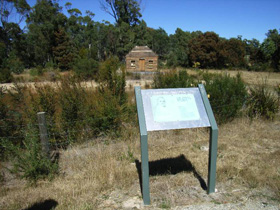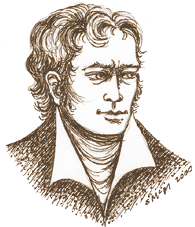Local History
West Tamar Historical Society
The West Tamar Historical Society aims to promote, protect and preserve the history of the West Tamar Municipality on the west side of the Tamar River north of Launceston, Tasmania. The society have a fantastic website that documents the local history of the West Tamar Municipal Area.
Visit the West Tamar Historical Society website at www.westtamarhs.com.au.
York Town 
York Town is the site of the first attempt to establish a British presence in northern Tasmania. For a brief period between 1804 and 1808. Col. William Paterson and his party of settlers, soldiers and convicts created a small, bustling village and established farms and a government garden at York Town. They faced many difficulties stock losses, poor soil, food shortages and episodes of robbery, bushranging and piracy.
Today, York Town is of national significance. Although all the original buildings have now gone, the landscape and natural setting remain largely unchanged. The site is interpretive and well worth a visit to learn about the town and how it operated. A diorama and findings from archaeological digs are on display 10 minutes away at the Beaconsfield Mine & Heritage Centre.
Charlotte Badger
One of the more intriguing stories from our region - considered Australia’s first female pirate - is that of Charlotte Badger. Convicted in 1796 and sentenced to 7 years transportation, there are varying stories on Charlotte’s colourful convict history in Australia, but the best comes from Tasmania and what happened there.
Charlotte incited a mutiny and inspired her fellow mutineers to take control of the ship Venus, anchored in the Tamar River, and sail it to New Zealand to start a new life, free from convict bonds. The ship contained many supplies for the fledgling colony of Yorktown, (the year was 1806), leaving them in the unenviable position of a) no supplies and b) a girl stole their ship! Legend has it that Charlotte, her fellow convicts and the crew had a rollicking time with the ships spirits while the Captain was ashore and when found by the Captain, was entertaining the crew with quote ‘an enthusiastic dance’ – quite possibly the dance of ‘see what’s above my garter’.
Disguising herself as a man while the Captain was distracted (I wish I had seen that) she then flogged the Captain with a pistol, raided a nearby vessel and merrily sailed down the Tasman to New Zealand. On reaching New Zealand Charlotte caught the eye of a Maori Chief in the Bay of Islands area who promptly took her in, in exchange for the crew......to eat. Perhaps a slight embellishment but one very good account has it the Maoris burned the ship Venus to retrieve the scrap metal, cooking the crew over the fire while it burnt. Even with a modicum of truth bending, it’s a great story.
Mathew Brady 
Debonair bushranger Mathew Brady had the honour of being Tasmania’s only bushranger to be invited in by his victims. Known as the fine mannered robber, Brady stole a basket and made a hamper out of rice, butter, bacon and sugar; not exactly a recipe for a romantic picnic, but enough to see him sail to Tasmania for 7 years. Having the distinction of capturing an entire garrison of redcoats, Brady had a handsome sum attached to his reward for capture – in return Brady posted a reward of 20 gallons of rum if anyone could bring him the Governor; fine mannered, romantic and with a sense of humour.
On the run for two years until finally captured, the flowers he received in jail while awaiting his hanging is testament to his popularity; all of the flowers were from female colonists, some even victims of his robberies, which suggests he may have provided something as well as taking something during his housebreaking! Mat also had the best perch in the valley with a 152 metre lookout and cave, at surprise, surprise – Brady’s Lookout - and when things go too hot he removed himself to, wow, so original, Brady’s Tree at Notley Gorge – big enough to house his whole gang.
Australia’s oldest colonial graffiti?
With the rather unfortunate, but probably quite normal name for the time, Adolarius Huxley had a rush of power in 1804. Sailing as a mineralogist with David Collins, Lieutenant Governor to Van Diemens Land, to settle Port Dalrymple, because Melbourne had ran out of water (Melbourne had to wait another 31 years for settlement), Adolarius was charged with obtaining fresh water from the Supply River, an inflowing stream into the Tamar River in Tasmania. Being a public servant and the most senior person in the dingy, he instructed the men (probably convicts) to row to a small set of falls and wander upstream to get fresh water – in the mean time, many hours later and becoming rather bored (the men had obviously decided to have a break from Huxley’s authority) he spent several hours with a hammer and chisel carving out ‘A H 1804’ into the solid dolerite, no mean feat and it’s still remains today, 210 years later. AH saw a rapid rise in the colony and also had the honour of becoming the first victim of infamous bushranger Michael Howe (famed in The Outlaw - Michael Howe movie 2013), much to the delight of all convicts in the state.
Sad but true - Tamar Island
Two rather sad endings for residents of Tamar Island – one, a farmer who, heartbroken after the death of his wife, never worked again, hitching his plough to a large Oak tree and departed the island. One story has it that the tree took on the spirit of the dead wife, embracing the plough tethered to it and is now in a permanent coupling; the only link to her husband she can tangibly hold. The other quite different - the story of Bruno the Bull.
Bruno was an isolated resident; the only large animal on the island which was cut off by the river on both sides. Local residents feeling sorry for Bruno attempted to free him from his solitary life with mixed results. Apparently Bruno quite liked ‘batching’ and saw off many attempts until a vet tranquilised him and moved him to a nearby farm to see out his days. The sadder story was the release of the delicious Angus burger at a nearby takeaway soon after, but unsubstantiated.....
Shocking Catastrophe!
Was the headline of the Launceston Examiner in 1874. Thank goodness the apostrophe, when used in conjunction of the death of 8 people, went out of vogue in 1875. The story of Little Nell was the result of a ‘street race’ gone wrong. Little Nell was puffing along the Tamar River near Dilston when she (all vessels are she) encountered a steam tug, the Tamar, and the race was on. Being a tug boat, the Tamar had a distinct advantage and to give Little Nell the best possible chance, the engineer blocked the steam safety valve to create more steam. Not a wise move by the engineer – the safety valve has a critical role, namely safety, and the result of blocking steam escaping has the effect of a pressure cooker without the relief valve. The subsequent explosion literally shattered the vessel, killing 8 people outright, their bodies ‘’flying high through the air’’ with another three injured. A quite different side to the story was of the large cache of gold on board that had locals searching the water for decades after.
Batman Bridge
Sounding more impressive when told in old school metrics, the Big A rises 299 feet above the water linking the east and west Tamar at Whirlpool Reach. 676 feet long with footings 59 feet sunk into the clay it’s an impressive sight. It’s had its fair share of drama with one gentleman in the 1970’s requesting assistance to help heave a heavy bag over the edge into the water....... which contained his mother, and a trio of eco warriors locking themselves in the frame to protest the pulp mill in the early 2000’s. More famous for its namesake Bat-Man – yes, he really does live in the big concrete abutment – poor old John Batman, the co-founder of Melbourne, wishes he had a sidekick called Robin too.
Australia’s longest navigable estuary
Tamar River or Kanamaluka in its indigenous guise captures around a dozen of Tasmania’s major rivers watershed – about 15,000 km2 of catchment area, which should keep the garden watered for a while. While Tasmania has a few Australian firsts, you’d be forgiven for thinking it couldn’t possibly have the longest navigable estuary in the country when the whole state could fit into the car park at Chadstone shopping centre. From Sea to city it’s 70km of waterway, then you add another 250kms of river flowing into it from the South Esk (although slightly less navigable with the odd dam or two in the way) Famous for its wetlands, Australia’s third oldest colonial settlement, Melbourne was founded from its banks and more recently home to Rebecca Gibney.